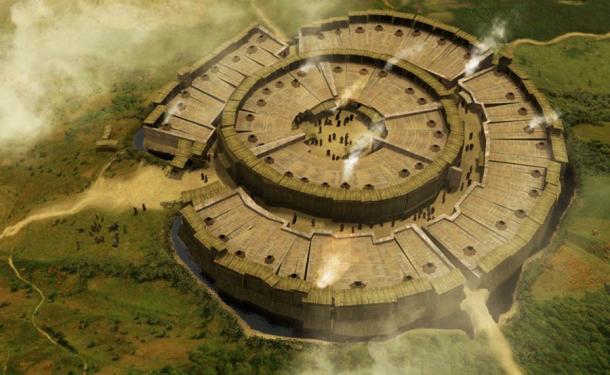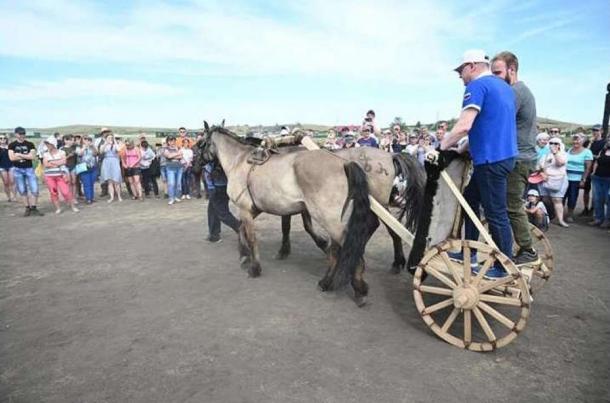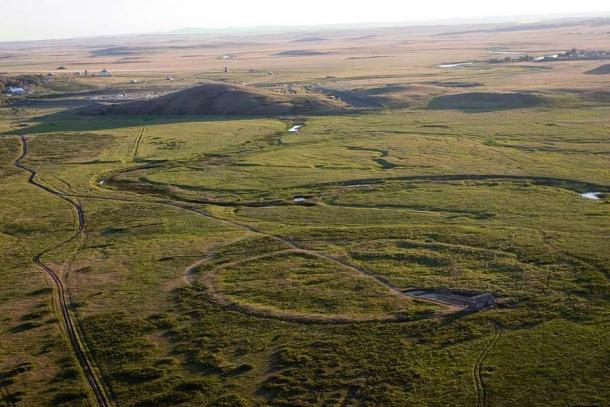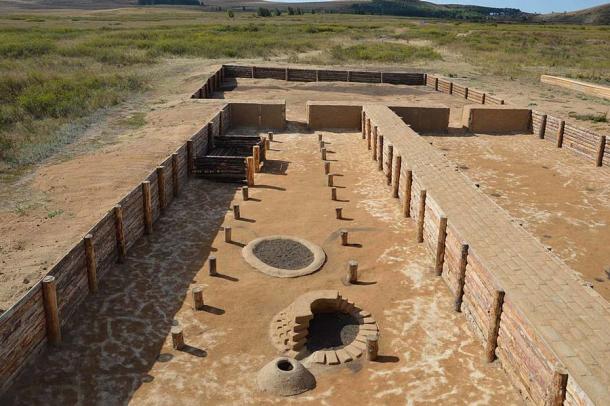Understanding the mysterious origins of the Indo-Europeans, the emergence of the Indo-Iranian languages, and the earliest identities of associated peoples remain some of the burning questions in modern scientific circles. These topics were extensively explored throughout decades of dedicated archeological excavations throughout Europe and Eurasia which yielded a variety of intriguing results offering a glimpse into the early formations of our shared identity.
Numerous associated “cultures” were identified, each one unique and showing the pioneering use of some revolutionary global innovations. One of these has been called the Sintashta culture, a society centered on the northern Eurasian steppe, where powerful horse-masters emerged, inventing war chariots and relying on forged weapons to subdue their neighbors and hasten the spread of their own language and culture. Who were these mysterious people?

Reconstruction of Arkaim archaeological site in Russia. (Reydekish)
Who Exactly Were the Bearers of Sintashta Culture?
Sintashta culture is known by a variety of names in modern archeology, including Sintashta-Arkaim and Sintashta-Petrovka, most of which are associated with its “type site”, the initial location of its discovery. The Sintashta archaeological site can be found in the Chelyabinsk Oblast in Russia, east of the Ural Mountains .
At the time a pioneering discover, the site includes the remains of a large fortified settlement. Ever since it came to light in modern scientific circles, the Sintashta archaeological site has been a bit of a puzzle. Archaeologists have pondered questions related to how to date the site accurately and who exactly were the people of this cultural horizon. These questions have not as yet been answered with 100% certainty.
Generally, Sintashta culture is considered to belong in the Middle Bronze Age of the Eurasian Steppe . As such, it arose on the borders of modern-day Central Asia and Eastern Europe, a vast area that was always the crossroads of civilizations and a hotspot for the emergence of new and unique cultures.
Sintashta Culture – An Amalgamation of Preceding Neighboring Cultures
In the initial period following the culture’s discovery, it was dated to have thrived from between roughly 2200 to 1800 BC. This was an estimate concluded after a series of 44 detailed C14 datings performed by the Russian Academy of Sciences. However, this age estimate has repeatedly been questioned by scholars, as it was considered outdated and inconclusive.
To that end, a new measurement was conducted. In fact, 19 calibrated radiocarbon datings (which are very accurate) revealed a more probable age of between 2050 to 1750 BC. Either way, it falls right into the Middle Bronze Age period, and it would come to dominate it in many regards.
What can be deduced with certainty is the fact that the Sintashta culture is likely the easternmost migration of the peoples belonging to the widespread Corded Ware culture . This has been proposed after extensive genetic studies. Established in this region, the bearers of the Corded Ware culture began their distinct journey of becoming a unique culture.
Of course, the Corded Ware culture blended with the pre-existing cultures of the area all the while. Thus, Russian scholars agree that the Sintashta culture emerged as a result of two cultures mixing: the Poltavka and the Abashevo cultures, both belonging to the Early to Mid-Bronze Age. As such, the peoples of Sintashta were truly a unique and new identity. It was a meeting point of the steppe cultural ancestry of the Poltavka peoples and forest-dwelling Neolithic hunter gatherers.

Replica of a chariot created by the Sintashta culture. ( South Ural State University )
Innovations of the Sintashta Culture
Most scholars agree that the Sintashta culture was home to some groundbreaking innovations, such as the use of chariots – especially for warfare. In fact, the earliest known two-wheeled chariots have been found in burials of Sintashta culture elites. This invention must not be understated, if we keep in mind that chariots completely changed the face of ancient warfare.
Chariots were a highly mobile and flexible weapon, drawn by one or two horses and operated by no more than two men – a “driver” and a warrior. The use of war chariots was one of the defining turning points in ancient history. Their use swept across the steppes and into Europe, and allowed those who mastered them to quickly subdue and conquer their foes. It is widely agreed that the peoples of the Sintashta culture were the ones to bring this design to life.
And this was just one of the several aspects that define this culture as highly militaristic. Sintashta people were likely oriented towards warfare. Besides their use of war chariots, they had another clear distinction compared to their neighbors: they lived in great fortifications. Around 23 fortified settlements have been found thus far, and they all show a degree of similarity.

The Arkaim fortress of the Sintashta culture. (Rafikova m / CC BY-SA 4.0 )
Arkaim – Circular Fortress Remnant of the Sintashta Culture
These Sintashta fortified settlements were erected at commanding locations, usually at higher ground, such as hills, hillocks and great earthen mounds. Many of them were surrounded by tall and formidable earthen walls and dykes, and show the implementation of complex design. By far the most famous of these strongholds is Arkaim, a circular fortress that came to be the most iconic symbol of the Sintashta peoples.
Arkaim consisted of two enormous concentric bastions, surrounded by walls made with adobe over timber frames and unfired clay bricks. These walls were roughly 5.5 meters (18.04 feet) high, and had a diameter of 160 meters (520 feet). Within these protective walls lay the sprawling and thriving settlement, which covered around 20,000 square meters (220,000 square feet) in its entirety.
The Arkaim settlement was also unique. The houses were usually built adjacent to one another, their walls touching, each one opening to the circular street that ran the diameter of the city. Another, inner set of houses existed, and these were arranged in a circle facing the open central “square”, which was likely used for ritual purposes.
Outside the city walls were cultivated fields. As such, Arkaim was a highly protected settlement, able to control the surrounding landscapes and defend itself efficiently from any would-be invaders. And it was this character of settlement that gave the Sintashta Peoples an upper hand.

The Arkaim settlement of the Sintashta culture has been partially reconstructed. (Rafikova m / CC BY-SA 4.0 )
A Nation of Elite Warriors and Master Smiths
Of course, each of these fortified settlements had a nearby burial ground – vast ancient cemeteries that proved to be an invaluable source of information for the archeologists. There was a general rule that dictated that for each settlement there was a single dedicated cemetery. The funeral complexes in each one vary – some have only a dozen burials, while others have much, much more.
Some burials house only a single skeleton, while some have several. Also, a clear distinction can be observed between warrior burials and those of the more ordinary members of this unique culture. Most often, Sintashta culture burials are defined by kurgans, special earthen mounds that had a multi-faceted purpose, and were perhaps reserved for the elite members of the society.
As with most ancient burials, a clear pattern can be observed. Most – if not all – contain lavish funerary goods and sacrifices. As a rule, dead men were accompanied by a horse (likely sacrificed), while woman and children were accompanied by small horned animals (likely sacrificed goats). Besides this, grave goods included numerous pieces of pottery, ornaments such as pendants and beads, and many types of weapons: spearheads, axes, knives, daggers, and arrowheads.
Some of the warrior burials are distinguished by other elite items, most notably protective cheek pieces made of antler, and the invaluable war chariots. By studying the remnants of the chariots, archeologists were able to partially reconstruct their overall design. It is probable that each of the wheels had 10 to 12 spokes, and that the distance between the wheels was around 130 to 160 centimeters (51 to 61 inches). As such, the war chariot of the Sintashta was a narrow, nimble, and potent weapon, able to be used in a variety of military situations.
Examining these weapons yielded some interesting conclusions. Besides the weapon types that were already established across the region – the axes, daggers, and arrows – some unique and innovative elements were observed. Firstly, numerous heavy socketed spearheads were discovered. These were newer, more potent spears, meant to have a heavy and long handle. As such, they were likely used as projectile weapons, perhaps thrown from the war chariots, and meant to have a tremendous piercing power.
Furthermore, arrowheads showed changes too. Inspecting their construction, we can assume that the arrows – and thus the bows – used by the Sintashta peoples were much shorter and smaller. These arrows were ideal not for long ranges, but for the close quarter piercing power, ideal for firing on the move and from the back of a war chariot.

In the Sintashta culture, as a rule, dead men were accompanied by a horse. ( ancient-wisdom)
Expanding Through Trade and Conquest
Another pronounced feature of the overall character of the Sintashta culture was a highly developed economy. All the discoveries and the remains point to the fact that the Sintashta peoples were advanced metallurgists. Thanks to this, their economy came to revolve around copper – both its excavation and its processing.
Numerous copper mines associated with this culture have been discovered, notably the Vorovskaya Yama mine. But this was no ordinary mining: it was conducted on a massive, industrial scale, and forging and smelting was at a highly advanced level. In fact, the excavated fortified settlements of Arkaim, Sintashta, and Ust’e, all revealed that common buildings contained smelting ovens, and slag, a by-product caused by the smelting process.
Of course, this mastery over metallurgy allowed the peoples of Sintashta culture to thrive and connect to the rest of the world. Evidence suggests that much of the metal they produced was exported to the prosperous cities of the BMAC – the Bactria Margiana Archeological Complex, a Bronze Age civilization which resided in Central Asia.
These thriving Near East cities were a window and a connection to more advanced technologies and a glimpse into an urban, civilized way of life – something that Sintashta peoples could only benefit from. In the later centuries, these important trade routes would prove to be the gateway to new lands to conquer and inhabit.
But who were these steppe war masters? Most scholars today agree that the peoples of Sintashta culture were the original speakers of the Proto-Indo-Iranian languages. This was the parent language of Indo-Iranian language family – itself a branch of the Indo-European language family.
This conclusion came from numerous similarities between the excavated Sintashta cultural traits, meaning their observed customs and traditions, and the traditions mentioned in the Rig Veda . The Rig Veda is an ancient Indian religious text whose early layers are one of the oldest extant texts in any Indo-European language. It is agreed that some parts of this text were orally transmitted through generations from as early as the 2nd millennium BC.
The Horse Masters that Changed the World Around Them
What we can understand is that the peoples of the Sintashta cultures inevitably had to expand. The pre-existing trade routes with the Bactria Margiana region allowed them to enter into the Near East, chiefly into the Indian subcontinent. They also migrated elsewhere, to Anatolia and Iran. Spurred by their innovative military techniques, their chariots and knowledge of metals, these peoples were able to expand quickly and conquer fast – as was iconic for all peoples of the steppes.
Genetically, the Sintashta peoples are documented to have been Caucasoids, with their distant origins likely being in Central Europe. This connects them to the forest-dwelling Neolithic hunter-gatherers, whose migrations led them further east, towards the Eurasian steppes . Similar genetic characteristics can be observed in the following cultures that emerged in the region also, the main one being the Andronovo culture .
In summary, it can be undeniably agreed that these steppe dwellers were advanced in every regard. They arose to the top in their cultural region, surpassing the neighboring cultures and taking the best elements from their origins to create something new, powerful, and revolutionary. From their militaristic culture, their fortified settlements, and all the way to the innovative war chariots, the peoples of Sintashta culture were masters of war and metallurgy. And in the Middle Bronze Age, it was exactly this that decided who lived and who died!
Top image: The Sintashta culture has been remembered for inventing war chariots. Source: Dark Heritage
By Aleksa Vučković
References
Anthony, D. W. 2010. The Horse, the Wheel, and Language: How Bronze-Age Riders from the Eurasian Steppes Shaped the Modern World. Princeton University Press.
Epimakhov, A. and Koryakova, L. 2014. The Urals and Western Siberia in the Bronze and Iron Ages. Cambridge University Press.
Kuz’mina, E. E. 2007. The Origin of the Indo-Iranians. BRILL.
Linduff, K. M. and Hanks, B. K. 2009. Social Complexity in Prehistoric Eurasia: Monuments, Metals and Mobility. Cambridge University Press.
 RSS Feed
RSS Feed















 December 23rd, 2021
December 23rd, 2021  Awake Goy
Awake Goy  Posted in
Posted in  Tags:
Tags: 













